Recent Articles
A Holiday Book List for Wine Lovers
With the holiday season upon us, I can’t think of a better gift for someone you love (or even someone you don’t like all that much, but for some reason are obligated to buy a gift for) , than a book about wine, save perhaps for a bottle of the actual stuff. In the time since I started writing this blog, I’ve read a fair number of books on this subject, many of them about the process of growing grapes and turning them into wine, others on the joys of drinking wine, and still others on some topical issue, such as the touchy subject of natural wine.
With that in mind, I thought I’d list a few books that might make a nice gift for a friend or stocking-stuffer (yes, I know, that would be some big stocking – but you can just leave it under the tree). Most of these are books I’ve read and enjoyed, and some are volumes that I’ve put on my own list. Among those in the category of books I’ve loved, I’ve either reviewed them or have plans (and yes, I have more plans than time) to write a review on Project Sunlight. So, stay tuned. Meanwhile, here’s the list:
Some Books I’ve Loved
Of all the books I’ve read about wine, I’ve enjoyed none more than Authentic Wine by Jamie Goode and Sam Harrop MW (Master of Wine). 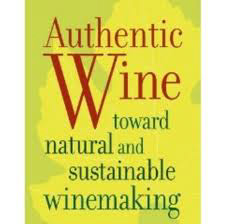 The book’s subtitle, Toward Natural and Sustainable Winemaking, gives a broad hint about where it’s heading, but one of the most appealing things about the book is its balance. The authors clearly respect the idea of natural wine and sustainable viticultural practices, but their first priority appears to be good wine, and they understand that a business isn’t sustainable if it isn’t profitable. Authentic Wine falls neatly into two parts, one dealing with viticulture and the second focusing on winemaking. I’ve read this book twice (you’d think after that I’d have taken the time to write at least a short review), and I’ll will probably read it yet one more time. They write intelligently and lucidly about a variety of current issues in the wine world, from reduction to the difference between natural and cultured yeasts to the trend toward riper fruit and higher alcohol levels. The get into the science and technical issues, but the writing is accessible and easy to follow. That’s quite a rare feat, and one of the reasons I’m so high on Jamie Goode.
The book’s subtitle, Toward Natural and Sustainable Winemaking, gives a broad hint about where it’s heading, but one of the most appealing things about the book is its balance. The authors clearly respect the idea of natural wine and sustainable viticultural practices, but their first priority appears to be good wine, and they understand that a business isn’t sustainable if it isn’t profitable. Authentic Wine falls neatly into two parts, one dealing with viticulture and the second focusing on winemaking. I’ve read this book twice (you’d think after that I’d have taken the time to write at least a short review), and I’ll will probably read it yet one more time. They write intelligently and lucidly about a variety of current issues in the wine world, from reduction to the difference between natural and cultured yeasts to the trend toward riper fruit and higher alcohol levels. The get into the science and technical issues, but the writing is accessible and easy to follow. That’s quite a rare feat, and one of the reasons I’m so high on Jamie Goode.
Also high on my list is Mike Veseth’s wonderful discussion of current wine industry trends, Wine Wars. (Reviewed March 28, 2013) Subtitled, “The Curse of the Blue Nun, the 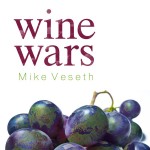 Miracle of Two-Buck Chuck, and the Revenge of the Terrorists,” this book ranges over a great deal of history to put some of the trends into context, and provides a lot of insight into some of the things, like Trader Joe’s and Costco, that are right in front of our eyes. Could a two-dollar (somewhat more outside of California) bottle of wine have succeeded if it had been sold anywhere else but at Trader Joe’s? In a world in which quality is often equated to price, it might not have worked at a retailer that had not already won the trust of its customers. And yet, in Europe, some perfectly drinkable wines sell (or at least sold recently) for a Euro a liter, making it effectively One-Buck Chuck. Mr. Veseth writes with the authority of the wine economist (a profession I did not know existed prior to reading this book), he is, and it’s clear that he not only knows a lot about wine, but that he loves it as well. The fact that his prose is both clear and engaging is just a bonus. Continue Reading–>
Miracle of Two-Buck Chuck, and the Revenge of the Terrorists,” this book ranges over a great deal of history to put some of the trends into context, and provides a lot of insight into some of the things, like Trader Joe’s and Costco, that are right in front of our eyes. Could a two-dollar (somewhat more outside of California) bottle of wine have succeeded if it had been sold anywhere else but at Trader Joe’s? In a world in which quality is often equated to price, it might not have worked at a retailer that had not already won the trust of its customers. And yet, in Europe, some perfectly drinkable wines sell (or at least sold recently) for a Euro a liter, making it effectively One-Buck Chuck. Mr. Veseth writes with the authority of the wine economist (a profession I did not know existed prior to reading this book), he is, and it’s clear that he not only knows a lot about wine, but that he loves it as well. The fact that his prose is both clear and engaging is just a bonus. Continue Reading–>
A Tough Year for a Weekend Vintner
It was a tough year to be a weekend vintner.
When you’re separated from your vineyard by a two-hour drive, you have to make the most of your time. And we try. But the weekends are short, and there’s so much to do. And every curve that Mother Nature throws your way puts you just a little bit further behind. This year, Mother Nature was throwing curves, sliders, and the occasional spitball.
This year began with a late spring frost, followed by rain. Not just a little rain, but lots of rain, which gave rise to all kinds of fungal disease potential. Powdery Mildew, Downey Mildew, Botrytis, you name it.
And then came the pests: Japanese beetles, birds, raccoons, squirrels, deer, and even bears. Yes, indeed, bears. No lions or tigers,though. Just birds, deer and bears. And yeah, racooons and beetles and the rest of the pests.
That’s one of the reasons I’ve not been able to pay much attention to this blog. Another was that Chris and I took on responsibilities for editing Grape Press, the quarterly publication of the Virginia Vineyards Association. But mainly it was the challenges of the growing season. It seems like we spent all of our spare time each weekend keeping up with the vineyard. Spraying, cultivating, pruning, and spraying. Yeah, lots of spraying. It wasn’t easy.
Let’s start with the late frost. I remember arriving at the vineyard early one Saturday morning to find our whites all but devastated. Honestly, it looked as though someone had sprayed Round-Up and left them to die. For a while, I actually wondered if they had been the victims of spray drift from the herbicide we had used to clear a row for new the new vines we had planted this year.
Fortunately, that was not the case.
After checking the temperatures recorded nearby, I realized that we had probably experienced at least one and possibly two frost events in which temperatures had dropped just below freezing for a few hours in the early morning. My reds were fine, but they are planted higher on the slope and there’s a good possibility that temperatures stayed a degree or two higher in their part of the vineyard. Alternatively, bud break came earlier for the whites and they may have just been victims of bad timing. I’ll never know.
It turned out okay, though. Both the Petit Manseng and the Viognier had enough secondary buds left to generate growth for this year. Within a few weeks, we were seeing buds break and shoots begin to develop. And by the middle of the summer, they were looking like grape vines again. So, all was well.
But then it started to rain. Continue Reading–>
Where Did the Grapes Go?
Five days ago, at the end of the holiday weekend, I was thrilled with the progress of our vines. We hadn’t allowed a lot of grapes to accumulate, given that the vines were only in their second year, but we had left a few clusters, and they looked beautiful. Moreover, they tasted amazingly sweet.
Alas, last weekend I had left my refractometer at the other house, and so I couldn’t measure the Brix, which would have told me how much sugar had accumulated in the grapes and therefore the potential alcohol. Not essential, given that we weren’t planning to make wine from this grapes, but it would have been nice to know. But I told myself, it’s Monday, I’ll be back on Friday, and I’ll be able to measure the Brix on Saturday morning. What could go wrong with that?
Well, of course, lots of things could go wrong. But what I wasn’t expecting when I returned this weekend was to find the grapes gone. Yes, gone. As in, missing. As in, virtually none of them left on the vine.
It turns out I was right about one thing. The grapes had ripened and accumulated a decent amount of sugar. Which meant that they were not only close to being ready for the crush, they had become attractive to lots of the critters that roam through the country near our vineyard. Birds, deer, badgers – who knows? Almost any animal cruising near our property could have decided to chow down on our grapes.
So, a few lessons.
First, we didn’t lose quite all the grapes. I had put bird netting up around some of the Cab Franc vines a few weeks before, and those grapes were largely intact. I measured the Brix and it came in at about 21.2 percent. Not bad. Not quite ready for the crush pad, but getting there. It’s been a horrible year with the rain and dark skies, but another week or two in the sun (assuming we get a week or two of sun) and they might have made pretty decent wine.
Second, among the grapes we didn’t lose were those in the “mother vineyard.” These are the Cab Franc vines we had planted in the first year before we even knew where the main vineyard would be located. We had purchased them for practice and never even really considered that we’d use them for wine. These, the critters left alone.
But why? Well, when I measured the Brix it was at about 16 percent. Not even remotely ripe enough for wine. So maybe these grapes were ignored because they weren’t sweet enough. Apparently the critters that hang around our property are pretty choosy in what they bite off. Continue Reading–>
Tempranillo, Part III
On the eve of our departure for WineMaker magazine’s annual conference, hosted in Monterrey, California, this year, I expressed some regret to the Vineyard Goddess that I didn’t have a bottle of home-made wine to take with me for one of the tasting events. I had bottled my Tempranillo some 35 days earlier, and while it was just past the bottle shock stage, I had not yet tasted it (and it was way too late to try it that night). For all I knew, it was plonk.
“Take it anyhow,” the VG told me. “Take two bottles. We can taste one on the first part of the trip, and if it’s good, you can take the other one to the tasting.”
Sage advice. I packed two, using my newly minted method of wrapping the bottles in bubble wrap (replacing my old method of wrapping them in t-shirts), and told myself we’d taste the first bottle when we arrived in Sedona on the first leg of our journey. As it turned out, I didn’t get to it until we reached the Grand Canyon for the second leg of the trip.
And what a surprise! It wasn’t the vintage of the century, but it was definitely good. I knew I had made some mistakes in the process, especially in the area of temperature control (overheating it at some points, and not keeping it warm enough at others), but it was still a good, solid drinkable wine. So, I felt confident that I could hold my own with the other winemakers, or at least not get ridden out of town on a rail.
The comments were generally favorable. The 100 or so winemakers who gathered for the tasting were seated at round tables of 10, and half the table rotated every ten minutes to be paired with new tasting partners. We tasted each other’s wine and provided feedback. I’d like to say that everyone was totally, if not brutally, honest, but I suspect we were more diplomatic than candid.
So, here are some of the comments:
“Young, but very hearty. As it ages, it will become a very nice wine.” (Oh, yeah, as it ages — someday it will be a decent wine!)
“Good tannins, good acidity, nicely balanced.”
“Good color, very dry. Nice tannins and structure.”
“Crisp acidity, not quite as much fruit as I’d like to see.”
Well, that’s as far as my notes go. Nobody was talking about long finishes or specific kinds of fruit on the nose or palate, but all in all, for a first outing, it wasn’t bad. As I said in a Facebook post, I had walked in with nightmares that my fellow tasters would spit my wine on the floor and then throw me out of the room. It was a relief to see that they all stayed and finished their taste of Bob’s Tempranillo.
Just off the Grape Press: New Editors
It’s a pleasure to announce that the Vineyard Goddess and I are now co-editors of Grape Press, the quarterly publication of the Virginia Vineyards Association. Our first issue is the just-published Spring 2013 edition, and while we took over editorial responsibilities too late to have had any role in the planning, we spent lots of time collecting articles, working with the authors on final edits, revamping the look of page 1, and dealing with the hundreds (well, dozens and dozens) of little details that come up as you’re going to press.
We’re very excited about this opportunity for a number of reasons. First, lots of folks in the Virginia viticulture community have been 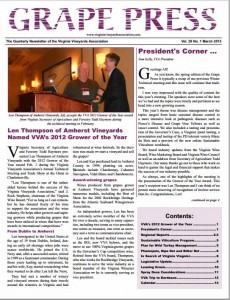 very generous with us, giving hours of their time to assist in our education. Early on, for example, I posted a note to a web site for the Central Virginia Winemakers group asking a question about how much time I should expect to set aside to manage a small vineyard I got lots of responses, and two of the folks who replied to my query hosted us at their vineyard for what amounted to a seminar on growing grapes.
very generous with us, giving hours of their time to assist in our education. Early on, for example, I posted a note to a web site for the Central Virginia Winemakers group asking a question about how much time I should expect to set aside to manage a small vineyard I got lots of responses, and two of the folks who replied to my query hosted us at their vineyard for what amounted to a seminar on growing grapes.
Secondly, we’re big fans of Virginia wine. We attended our first Virginia wine festival some 25 years ago, and while the wines weren’t great back then, some were pretty good, and we thought they all had promise. We were right. The wines got better each year, and today, we think Virginia wines have really come into their own. Virginia Viognier is a world-class wine. Cab Franc, Merlot, Petit Verdot, Petit Manseng, Norton and a number of other grape varieties have been made into truly great wines. My personal view is that a number of the Commonwealth’s wineries are making wines that can compete anywhere in the world, and their ranks are growing each year.
A major reason for the continued improvement in Virginia wine is the quality of the fruit that wineries have to work with. As the old saying goes, wine is made in the vineyard. And the quality of the fruit is improving in no small part because of the willingness of so many in the business to help each other out. In this industry, people share knowledge. Grape Press is part of that process, and the Vineyard Goddess and I are thrilled to be able to play a part, however small, in the continued growth of the Virginia wine industry
As I said, we can’t take credit for the range of high-quality stories in the current edition, but we did have a chance to work with the authors, and it was one of the best journalistic experiences of my life. The writers were all involved in one aspect or another of viticulture, from the distinguished vineyard consultant Lucie Morton to grape pathologist Mizuho Nita to Ankida Ridge vineyard owner Christine Vrooman.
The writers were knowledgeable and intelligent, and their articles were infused with personality and wit, which made them a pleasure to read. I won’t try to mention everything from this issue, but Christine Vrooman’s series on sustainability, Andrew Hodson’s article comparing French and Virginia Viognier, and Jim Benefiel’s story on a VVA expedition to Bordeaux are among those I would recommend to anyone. And honestly, there isn’t a bad article in the whole issue. Bill Freitag, Katie Hellebush, Pete Johns, Lucie Morton, Mizuho Nita and Dean Triplett contributed excellent articles, and they’re all worth a read. For what it’s worth, I read the entire issue, word for word, at least twice, and I enjoyed it as much on the final read as I did on the first round of edits.
Membership in the Virginia Vineyards Association is a must for anyone involved in the Virginia wine industry. But Grape Press is great resource for anyone interested in viticulture, no matter where you live. It’s a great publication, and Chris (the Vineyard Goddess) and I will be doing our very best to ensure hat it continues to be great.
Wine Wars: Terroir’s Last Stand?
Reading Wine Wars, Mike Veseth’s superb book about the forces shaping the modern wine industry, brought two memories to mind, one of fairly recent vintage, the other decades old.
I’ll start with the older one, which involves a college night with friends. For reasons that I’m sure made good sense at the time, we decided it would be fun to buy a bottle or two of the cheapest wines we could find on the shelf at a nearby 7-Eleven. I don’t remember exactly what we bought or what I drank, but the names Thunderbird, Boone’s Farm, and Blue Nun spring to mind. I also can’t recall how much we paid for them, but it seems like they must have been a couple of dollars each, in line with the cost of a six-pack of beer in the late 1970s. And, oh yes, I vaguely recall waking up the next morning with a killer hangover.
The more recent memory involves a lunch in Madrid a couple of years ago. On the way 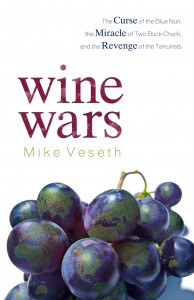 to the Prado museum, we stopped at a nearby restaurant for a quick lunch. I ordered the menu del dia, or menu of the day, a common offering at Spanish restaurants that generally features a soup or salad, an entrée, a desert and a choice of beverages. When I asked about the choice of beverages, I was offered soda of some kind, water, coffee, tea, or wine. Naturally, I asked for red wine, pleasantly surprised, but realistic enough to expect nothing more than a glass of something that would be innocuous at best.
to the Prado museum, we stopped at a nearby restaurant for a quick lunch. I ordered the menu del dia, or menu of the day, a common offering at Spanish restaurants that generally features a soup or salad, an entrée, a desert and a choice of beverages. When I asked about the choice of beverages, I was offered soda of some kind, water, coffee, tea, or wine. Naturally, I asked for red wine, pleasantly surprised, but realistic enough to expect nothing more than a glass of something that would be innocuous at best.
A few minutes later, the waiter brought a bottle to our table, set it down, and said something that I took to mean, “this bottle is all for you.” When I questioned him, he repeated the phrase. And I understood. Yes, it was mine, all mine. The entire bottle.
The meal probably cost 8 or 9 Euros, about $11 or $12 at the current exchange rate, at the bottom end of what I would expect to pay in any major U.S. city for a decent lunch at a nice, but inexpensive restaurant. Two things struck me about that transaction. First was the recognition that back home, the price of the meal would barely have covered a glass of wine, if that, along with a decent course or two of food. But what really surprised me was the casual way they threw in the full bottle. We’re talking wine, after all, not water from the tap.
I wondered off and on in the intervening years how it could be possible to serve a bottle of wine with a meal as though it was nothing more than a cup of bad coffee. Wine Wars gave me some answers.
Mr. Veseth discusses three major trends shaping the world of modern wine: globalization, “the miracle of Two Buck Chuck,” and what he refers to as “the revenge of the terroirists.” Continue Reading–>
Tempranillo, Part II: The Hydrometer Never Lies
I was pretty excited last Monday when I began making six gallons of Tempranillo wine. I thought I had been pretty clever in the way I had gotten the temperature just right before pitching the yeast, and I was pretty confident that things would go well.
And 24 hours after inoculating the unfermented must with yeast, I was pretty sure fermentation was well underway. The airlock was beginning to accumulate carbon dioxide, or CO2, bubbles and there was a fragrance in the air that I have always associated with fermentation. Also, there was a loud hissing sound inside the primary fermenter said there was something alive and growing inside. Yeast is a truly amazing microorganism.
Forty-eight hours in, I was beginning to worry. The airlock wasn’t bubbling up and down in the vigorous way I had expected, and I wondered if the fermentation had become stuck. Or worse, if it had actually been stillborn, and I had only been deluding myself the day before. I punched down the grape skins for a couple of minutes (the grape skins are pushed to the top of the fermentation vessel by the CO2 released during fermentation, and they must be “punched down” daily to ensure proper contact with the must – more on this in a later post) and then checked the temperature.
The results were a bit scary – almost 90 degrees. Apparently the heater I was using was a blunter tool than I had thought. That seemed a bit unjust. The last time I made wine, fermentation took forever, and was briefly stuck because I had let the house get too cold. Now, I had apparently gone too far in the other direction.
On Thursday, I was feeling even worse about the fermentation. I had shut down the heater, and the temperature had dropped to the low eighties.
Better for fermentation, but probably still a bit too hot to re-inoculate. I knew I could get the temperature down, but I wasn’t really sure how to go about reinoculating.
I had packages of two different kinds of yeast: RC212, which was the particular kind of yeast that came with the kit, and EC1118, a champagne yeast that is also supposed to be good for restarting stuck fermentations. I wasn’t sure which to use, whether I should rehydrate the yeast with some of the juice before pitching it, or whether I should get the temperature down first. So, I called the company’s technical support line.
I was using a Winexpert kit, and I can’t begin to say enough about their customer support. I got a real person on the phone in a couple of minutes, and she was terrific. Here’s how the conversation went (picking up after I explained the problem):
She: What was the specific gravity when you pitched the yeast?
Me: 1.082
She: What is it now?
Me: I haven’t checked, but since it doesn’t seem to be fermenting, I assume it’s still right around 1.08.
She: You need to check. Give me your number, and I’ll call you back in ten minutes while you take a reading.
Me: OK.
After about ten minutes, she called back.
Me: I just finished sanitizing the hydrometer and wine thief and I’m just filling the tube (for the hydrometer).
She: OK.
Me: Uh. . . Can this possibly be right? It looks like it’s 1.02.
She: You got it! It’s working.
Me: Uhhhh . . . yes, it is. (but thinking, yes, I am an idiot. . .)
What I learned from her was to rely on the hydrometer, not my visual checks. She was good enough to stay on the phone with me for another five minutes to talk about winemaking and to answer a few more questions about the kit. Honestly, it was one of the best customer support experiences I’ve ever had.
So, I let the wine continue fermenting. Twenty four hours later, the specific gravity was down to 1.011, and the night after that, it was just a hair over 1.000, maybe 1.001. Sunday morning, I’ll check again, and I think it will be time to rack it into a carboy for the secondary fermentation.
Meanwhile, I’m planning to start making a new batch of wine in a week or two, this time Winexpert’s Lodi Ranch 11 Cabernet Sauvignon. And I’ll be relying less on visual observations and more on things I can measure, like temperature, pH, and specific gravity.
After all, your eyes may deceive you, but the hydrometer never lies.
Making Tempranillo, Part I
So much of what I’ve written on Project Sunlight has to do with the vineyard – planting vines and tending them until they’re ready for that first harvest. Well, okay, we’re actually a long ways from that first harvest, so in fact most of what I’ve written has to do with that first year in the vineyard, from preparing the ground to planting and caring for the vines over the course of that year. Someday soon, I hope to write the next chapter, the one that has to do with turning simple grapes into something noble. But we have at least another two years before we take that step and make wine from our grapes.
And yet, I want to make wine – now. So, what to do? I am very hopeful that next fall I’ll be able to buy fresh fruit from somebody else’s vineyard, and make wine from those grapes. But that’s a long ways away, and I’m feeling a need to get some experience with the whole process of fermentation before I start playing with freshly harvested grapes. It’s also possible I’ll be able to buy some grapes shipped in from Chile in the next month or so (the southern hemisphere runs opposite to our world – our fall is their spring, and their spring is our fall), but I’m not sure about that.
Wine kits, though, offer a world of possibilities – literally. You can get kits that contains juice and crushed grapes from Argentina’s Mendoza region or South Africa’s Western Cape. You can buy Chilean Cabernet Sauvignon or Australian Shiraz or Oregon Pinot Noir, for that matter, and make those wines at home whenever you want.
Years ago, I turned my nose up at the idea of making wine from a kit. But from what I’ve read over the past few years, kits have gotten better and better. Two years ago, after receiving a starter set with all the equipment from my daughter as a Christmas gift, I tried my hand at one. I made so many mistakes that I should have been grateful to have ended up with decent vinegar. But I worked hard at it, and when I was finished I decided that the very least I could say about it is that it was honest to God wine.
I wondered if that would be the most I would ever be able to say about it as well, and I suppose the answer is somewhere in the middle. It wasn’t great wine, but my kids liked it well enough to ask me to bring a couple of bottles with me when I traveled out to visit (in California, no less), so it at least found an audience. And every time I open a bottle, I tell myself, “Hey – this ain’t so bad.” And yes, I know – that’s a pretty low hurdle.
In any event, I decided to try my hand at it again. This time, I’m making a Spanish Tempranillo, one of my favorite varietals. The kit was made by Winexpert, and it came with a bladder of juice, a smaller bladder of crushed grapes, and of course all of the yeast, fining agents and the like that one needs to turn the juice into wine. Continue Reading–>
Looking Back on the First Year
So, now that we’ve been through most of a full season, from preparing the ground and putting in the trellis, to planting and nurturing the vines all the way through the “harvest” (three clusters that grew despite our efforts to keep the vines free of fruit), I think it’s time to enjoy a glass of someone else’s wine, reminisce happily about how well everything turned out, and then get down to the serious business of evaluating what we did right and what we did wrong. On the plus side, I think we got a lot of things right. We spent more time than I care to remember researching and thinking through what varietals we would plant and more specifically, what clones would do best on our property – 740-feet above sea level, on a steep, westward facing slope in Afton. We settled on four grapes – Cab Franc, Petit Verdot, Viognier and Petit Manseng – and I’m very happy with the choices we made. We’re thinking of putting in some Merlot next spring, but I think the four we started with are great grapes for Virginia.
- My job was to dig the holes. . .
- In a more or less straight line.
- And my wife, the Vineyard Goddess, did most of the planting.
We decided to go with ENTAV clones, and worked through three different nurseries to get the vines we wanted. For the record, we ended up getting ENTAV 214 Cab Franc; ENTAV 573 Petit Manseng; ENTAV 400 Petit Verdot; and ENAV 642 Viognier. We put all of them on 101-14 rootstock. Continue Reading–>

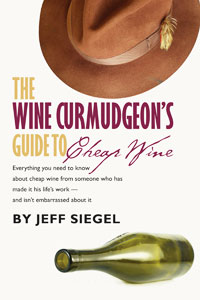
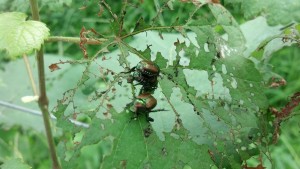
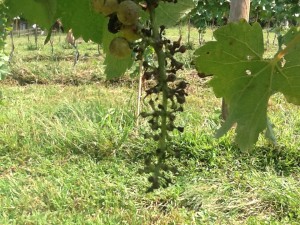
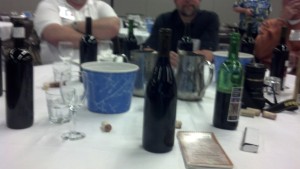
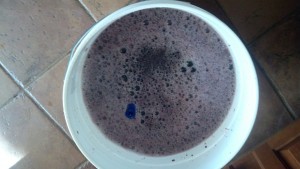
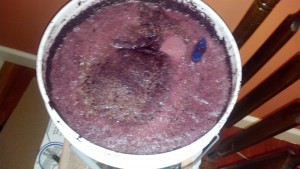
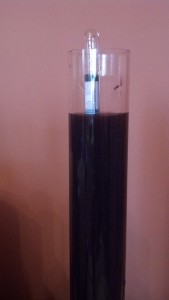
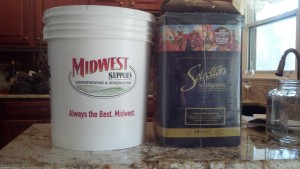
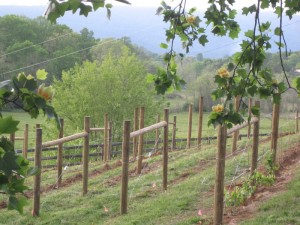
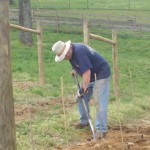
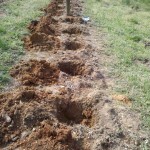
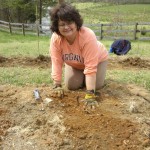


Recent Comments